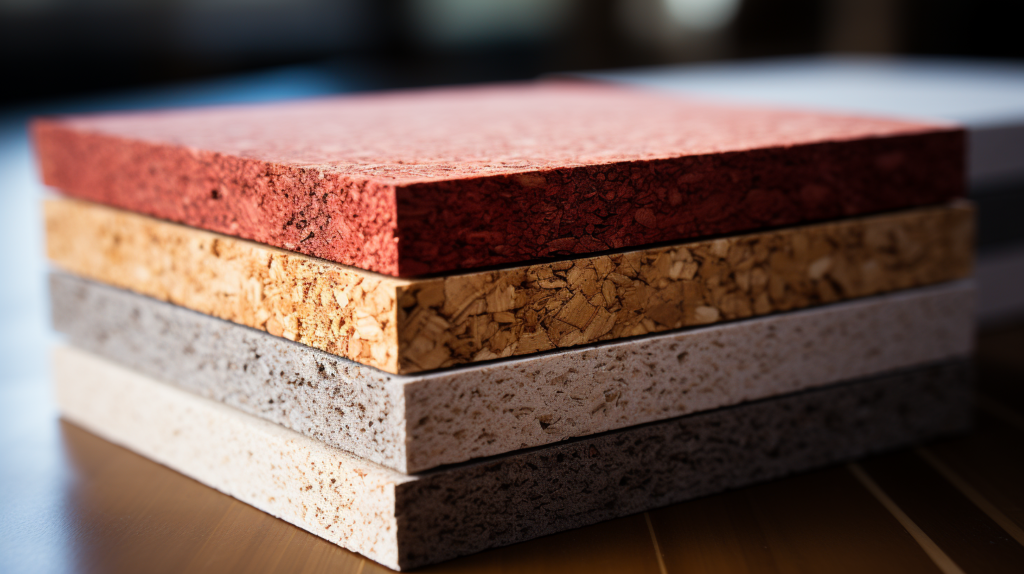Imagine installing cork tiles for peace and quiet, only to find that the noise persists.
This common scenario sparks a crucial inquiry: Are cork tiles truly effective for soundproofing?
The reality is complex, with cork offering benefits yet falling short of being a soundproofing cure-all.
Let’s dive into the nuanced world of acoustics, where cork plays its part alongside a symphony of other materials, to craft the tranquil spaces we desire.
Understanding Soundproofing

Soundproofing is a science that intersects with the art of architecture and interior design, balancing the practical need for quiet with the aesthetics of living and working spaces.
It is more than just preventing noise from traveling in or out of a room; it’s about creating environments that are acoustically pleasing and functionally sound.
This delicate balance is achieved by incorporating materials and designs that absorb, dampen, or block noise, thus enhancing the quality of life and productivity in various settings.
The principles of soundproofing are rooted in the behavior of sound waves as they interact with different surfaces and materials.
When sound waves encounter a barrier, they can be absorbed, reflected, or transmitted. Effective soundproofing materials are those that can reduce the transmission of these waves, preventing unwanted noise from passing through.
The design and materials used for soundproofing take into consideration factors such as the frequency of sound, the environment’s intended use, and the level of sound isolation required.
A good soundproofing material is typically dense, offering mass that sound waves find difficult to penetrate. However, density alone isn’t enough.
The material’s ability to convert sound energy into a different form of energy, typically heat, is what truly defines its soundproofing effectiveness.
For instance, mass-loaded vinyl is a common soundproofing material favored for its high density and flexibility.
It can be added to walls, floors, and ceilings to dampen vibrations and reduce the transmission of sound.
Thick layers of drywall, also known as gypsum board, are another standard in soundproofing. Its dense composition and mass make it a staple in constructing walls that require sound attenuation.
Special acoustic foams are designed with open cell structures that trap sound waves and diminish their energy as they pass through, making them ideal for studios and rooms where control of sound reflection is necessary.
Understanding these principles is key to choosing the right materials for any soundproofing project.
Whether it’s for a home theater, a private office, or a recording studio, the correct combination of materials can significantly improve the acoustic quality of a space.
Beyond the primary soundproofing materials, other elements such as seals for doors and windows, acoustic caulks, and insulation also play a vital role in ensuring complete sound isolation.
Is Cork A Good Soundproofing Material?

Cork has been lauded for its environmental sustainability and aesthetic versatility, making it an attractive option for many builders and homeowners.
However, when it comes to soundproofing, cork’s capabilities are often misunderstood. While cork’s physical properties lend it to certain sound management applications, it is not the panacea for all soundproofing needs.
The cellular nature of cork makes it an excellent insulator. Each cell acts as a tiny barrier, disrupting the path of sound waves and thereby reducing the sound energy that passes through.
This quality makes cork an effective material for minimizing surface echoes and improving the acoustic character of a room.
The presence of cork can soften the harshness of noise, making it a popular choice for use in rooms where a reduction in ambient sound is desired.
However, when considering cork for soundproofing, one must account for its limitations.Cork’s density is less than that of many other soundproofing materials, which means it can only absorb so much sound.
The average thickness of cork panels may not provide the mass required to significantly reduce noise transmission.
In areas where soundproofing is critical, such as home theaters or recording studios, relying on cork alone would likely be insufficient.
Instead, cork should be considered as part of a broader sound management strategy.
Cork’s suitability for acoustic treatment rather than outright soundproofing stems from its ability to dampen and disperse sound within a space.
It can be used effectively to line walls in conference rooms or studios where the clarity of sound is essential.
However, for spaces requiring strict sound isolation—from bustling city noise or the cacophony of industrial work—materials with greater mass and specialized soundproofing constructions are necessary.
Comparing Cork To Other Soundproofing Materials

The quest for tranquility in living and working spaces often leads to a comparison of various soundproofing materials.
Cork, with its environmentally friendly appeal, competes with a range of other materials, each with its own set of benefits and drawbacks.
When placed alongside traditional soundproofing materials, cork’s performance can be more accurately assessed.
Materials like mineral wool and fiberglass are industry standbys when it comes to soundproofing.
Their fibrous structures are excellent at trapping sound waves, effectively reducing the amount of noise that passes through them.
These materials are dense, thick, and can be installed within walls, above ceilings, and beneath floors, providing a robust barrier against unwanted noise.
They are particularly effective in settings where stringent soundproofing is necessary, such as in commercial buildings or residential areas with high levels of environmental noise.
In contrast, cork is lighter and less dense. While it can absorb sound to a degree, its natural structure is not as adept at blocking noise as mineral wool or fiberglass.
The porous nature of cork allows it to act as a cushion, dampening vibrations and impact noise, which makes it a suitable choice for floor underlayment.
However, when it comes to the airborne sound that one might want to block out from a busy street or an adjacent apartment, cork tiles alone are insufficient.
Soundproofing panels from companies like Burton Acoustix are engineered from materials such as nitrile butadiene rubber.
This material is specifically designed to dampen sound and is denser and heavier than cork. These panels can be applied to walls or ceilings to mitigate a wide range of frequencies, including the lower ranges that can be particularly bothersome and harder to block.
The technical design and material composition of such panels make them a more effective solution for soundproofing than cork.
In a head-to-head comparison, cork may fall short in soundproofing abilities but holds its own as a material that can improve the acoustic quality of a space.
For individuals looking to create a peaceful home environment, combining cork with other soundproofing materials can yield an effective multi-layered approach to sound management.
Possible Places Cork Can Be Used For Soundproofing Purposes

Cork’s natural sound absorption qualities can be harnessed in specific applications where its limitations in thickness and density do not pose significant issues.
One such application is in flooring, where cork can serve as an acoustic underlay. Its compressibility makes it an excellent choice for reducing impact noise, such as the sound of footsteps or dropped objects.
When used beneath a floating floor, cork can contribute to a noticeable reduction in noise levels, making it a popular choice in multi-story buildings where foot traffic noise can be a concern.
However, the challenge with cork arises when it comes to its ability to prevent sound penetration, particularly in the context of airborne noise.
The thinness of cork means that it does not provide a substantial barrier to noise from outside sources. In settings where conversations need to remain confidential, such as in law offices or medical facilities, additional soundproofing measures would need to be employed.
Cork can still play a role in these environments, not as the primary soundproofing material but as part of a composite solution that might include denser materials and soundproofing construction techniques.
Cork’s use as an underlay should not be underestimated. In addition to its sound-absorbing properties, cork is also a natural thermal insulator.
This means that in colder climates, a cork underlay can contribute to the overall warmth of a room, adding comfort along with noise reduction.
Its resilience also means that it can withstand the wear and tear of everyday use, maintaining its sound-absorbing properties over time.
When considering the use of cork for soundproofing purposes, it is essential to match the material to the specific needs of the space.
For areas where the primary concern is echo and reverberation, such as in a home theater or a music practice room, cork wall tiles can improve sound quality.
But in environments where the goal is to block sound from entering or leaving the space, cork should be used judiciously, in combination with materials that offer higher sound transmission loss.
Alternatives To Cork For Soundproofing

When considering the needs of a space that requires serious soundproofing, there are several alternatives to cork that offer superior noise reduction capabilities.
These materials are designed to address the full spectrum of soundproofing challenges, from airborne noise to structure-borne vibrations, and are selected based on the specific acoustic demands of a project.
Mineral wool, for instance, is a heavyweight contender in the arena of soundproofing.
Its high density and fibrous composition make it ideal for absorbing sound waves, thus preventing them from traveling through walls, floors, and ceilings.
Its effectiveness is heightened when used in conjunction with resilient channels, which are metal strips that create a decoupling effect, further isolating sound.
Fiberglass insulation is another popular choice for its sound-dampening properties. It works similarly to mineral wool but is often preferred for its ease of installation and cost-effectiveness.
Both materials are particularly adept at handling airborne noises, such as conversations or traffic sounds, and when installed correctly, can significantly improve the STC rating of a structure.
Nitrile butadiene rubber, used in soundproofing panels, offers a modern solution to noise control. These panels are engineered to absorb and deflect sound, providing a barrier to noise.
While they are effective against airborne noise, their performance against structure-borne noise is somewhat limited.
However, they still represent a solid option for areas where noise reduction is of paramount importance.
The choice between these materials often comes down to the specific requirements of the space and the nature of the noise problem.
For instance, in a recording studio where sound clarity is critical, dense soundproofing panels may be preferred.
In residential settings where the goal is to dampen the noise from adjacent apartments or busy streets, a combination of materials, including mineral wool or fiberglass with additional soundproofing layers, may be the best approach.
Conclusion
In summary, cork’s role in soundproofing is best viewed as part of a larger acoustic strategy rather than a complete solution.
It’s excellent for reducing echoes and softening impact noise, making it a valuable ally in enhancing room acoustics.
For substantial sound isolation, however, heavier-duty materials like mineral wool, fiberglass, and rubber panels are necessary.
Understanding cork’s capabilities allows for its effective use where it excels and acknowledges when to employ more robust materials for optimal sound isolation.
In the end, creating a quiet and acoustically pleasing space is about layering the right materials to meet the specific sound challenges of any given environment.
With careful planning and the right mix of soundproofing strategies, achieving a harmoniously silent space is well within reach.
Frequently Asked Questions (FAQ)
How Do You Soundproof A Room With Cork?
The role of cork in soundproofing is often misunderstood, leading to the misconception that it can be used as a primary material for sound isolation.
In reality, cork is more suited for acoustic treatment, which involves improving the quality of sound within a room rather than preventing sound from entering or leaving it.
To truly soundproof a room, one should consider materials like MLV, dense foam panels, or double layers of drywall with damping compounds.
Is Cork Better Than Drywall For Soundproofing?
When it comes to soundproofing, drywall, especially when used in multiple layers or with added mass, outperforms cork.
Its higher density and mass make it more effective at blocking sound transmission.
Cork, on the other hand, can be used in conjunction with drywall to enhance the room’s acoustics but should not be relied upon for isolation purposes.
What Is The Soundproof Rating Of Cork?
Cork typically has a low STC rating, generally between 15 and 20, indicating that it is not highly effective at blocking sound.
This rating is significantly lower than other specialized soundproofing materials, which can have STC ratings of 50 or more.
The STC rating of cork makes it more suitable for acoustic correction rather than for soundproofing.
What Is The Best Flooring For Soundproofing?
The best flooring for soundproofing combines a solid, dense material for blocking airborne sound and a resilient underlay to reduce impact noise.
An acoustic underlay, possibly made of cork, can be used beneath a floating floor to reduce footfall and other impact noises.
However, for comprehensive soundproofing, additional layers such as MLV are recommended to provide a higher degree of sound isolation.
